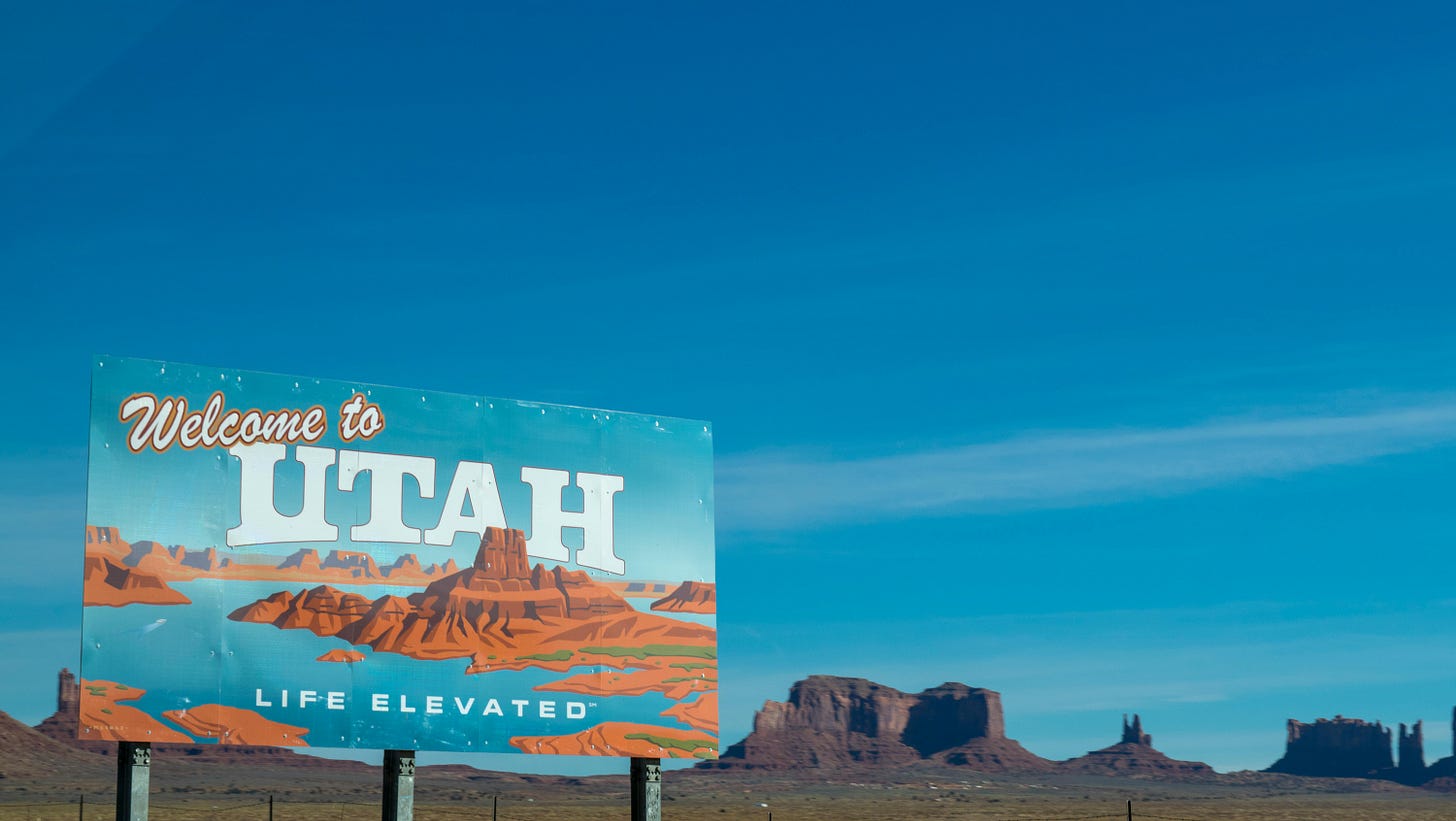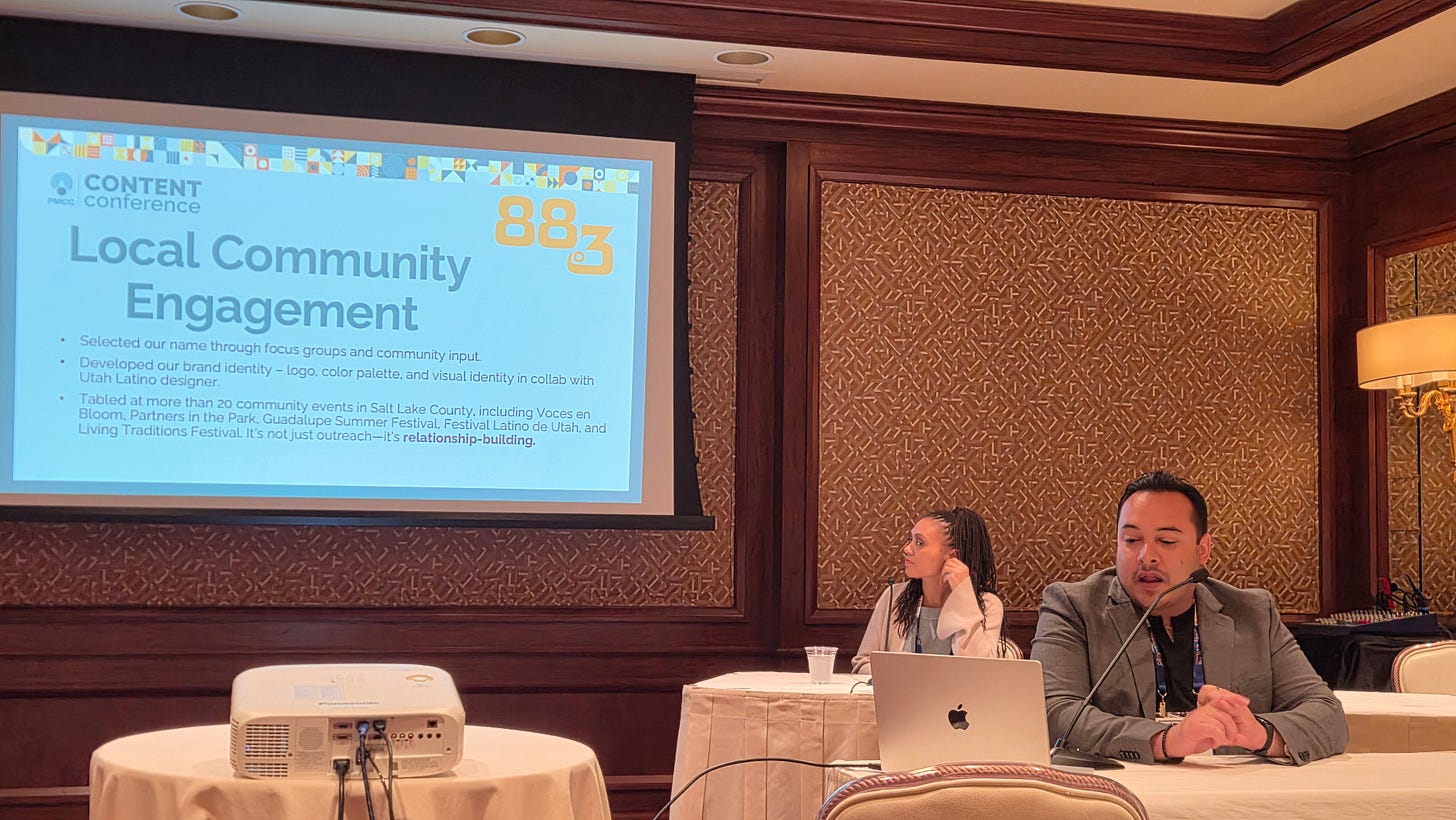Creating a home for Latino public media
One year in, Avanza is growing trust, experimenting and building something joyful
Let me offer you something instructive out of the the 2025 Public Media Content Conference, which recently took place in Salt Lake City.
When Edgar Zúñiga joined Avanza in July 2024, the new bilingual public radio station was barely more than a legal ID. It aired Spanish-language music and news syndicated from California, with no name, no staff and little local content. But a year later, Avanza 88.3 is carving out a unique space in Utah. It’s one centered on cultural identity, trust and joyful connection with the Latine community.
“I think we really know who we are,” Zúñiga told attendees. “That helps. We have a solid identity, and that’s really important when you’re trying to build community.”
A local voice for Utah
Avanza serves a diverse Latino audience that often doesn’t hear itself reflected in existing Spanish-language media. Commercial Spanish-language radio in Utah is abundant, with four stations and affiliates of Telemundo and Univision. But much of it is heavily focused on music or national stories, often with a distinctly Mexican-American or California-centric lens.
For many Latinos in Utah, especially those born or raised in the U.S., those stations don’t fully reflect their bicultural or bilingual reality. Avanza aims to fill that gap. Its programming includes a mix of English, Spanish and Spanglish content, tailored to both recent immigrants and established residents.
“If we’re talking about immigration or accessing social services, that’s in Spanish,” Zúñiga explained to the programming leaders in the room. “If it’s about navigating two cultures, that might be in English or Spanglish. It’s about meeting people where they are.”
The station’s local programming is still modest: one weekly public affairs show, short two- and five-minute segments, and music programming sourced from partners. But Zúñiga says they’ve seen “superfans” emerge despite their limited hours. Avanza’s social media videos have already topped 10,000 views.
Volunteers and AI
With a small team and limited resources, Avanza has turned to creative strategies to expand its content, starting with translation. Many of the stories they publish originally come from sister station KUER, especially those with relevance to Latinx communities.
Zúñiga initially translated those articles himself, but as the workload grew, Avanza began using Microsoft Copilot for first drafts. Every AI-translated article is reviewed and corrected by a human editor. “It’s way faster to edit an AI translation than to start from scratch,” he said. “But you absolutely have to humanize it.”
Why? Because language is culture. “There are 15 ways to say ‘straw’ in Spanish,” Zúñiga mused. A word that’s neutral in one country can be offensive in another. So Avanza tries to use “neutral Latin American Spanish” and, when needed, defaults to the Mexican variant most familiar to local audiences.
They’re also transparent about using AI. “We tell our readers when we use it,” he mentioned. Avanza builds their editing feedback into future prompts, making the system smarter over time.
This hybrid approach of AI for speed, human editors for nuance has opened up more space for community volunteers to contribute, whether in translation, writing or simply connecting the newsroom with local organizations.
Growing the audience
Although still in early days, Avanza is already seeing encouraging signs. Its listenership has grown since launch, newsletter open rates are over 70 percent, and sponsors have come on board, with some partners stepping in even before the station had branding. Local car dealerships, museums and even PBS Utah and KUER sponsors have signed on, along with new interest from Latino-owned businesses.
But Avanza isn’t rushing into traditional pledge drives yet. Instead, it’s focusing on building relationships first. “The community we’re reaching may not be familiar with public radio or what it means to be a member,” Zúñiga said. “We’re taking time to educate and connect before we ask for support.”
The team has prioritized outreach through local events and community tabling, consistently gathering new signups and hearing from listeners who stumbled upon the station and felt seen. “Some say, ‘I was in the car and found you—and I love it.’ That’s humbling.”
READ: The story behind Avanza.
Shifting landscapes
Avanza’s mission feels increasingly urgent as federal agencies roll back multicultural communications initiatives. Zúñiga believes public media has a responsibility to step up. Moreover, he sees Avanza filling a gap that commercial stations can’t. Many are under-resourced, focusing on crime, weather or traffic. “They don’t have the bandwidth to dive into the intricacies of what’s happening locally.”
Avanza’s approach of layering translated news with original content, community voices and celebration is a model for others. “Just having Spanish-language content on your website or social media makes a difference,” he said. “Even if you don’t have Latino staff right now, start with volunteers. Be honest and humble about where you’re at. Communities will feel that.”
For Zúñiga, Avanza is personal. He grew up in Utah without seeing himself reflected in media. That sense of community is what fuels his optimism. “Avanza’s future is tied to the joy of the local Latino community. And we’re not outsiders. We’re part of it.” 🟢
Cafecito: stories to discuss ☕
200 shows. Vientos del Sur, a weekly two-hour radio program on North Carolina community radio station WCOM, hits a milestone. 📻 The Daily Tar Heel has the story behind the music/talk show.
Latine audience growth. The latest research into the new Nielsen three-minute qualifier demonstrates marked growth in Hispanic and Black listeners. 🎤 Westwood One lays out the numbers.
Community licensee on the list. California’s Press Democrat spotlights three radio stations seeking to serve Latinx listeners amid the current immigration crackdown. 🎛️ KBBF is among the broadcasters profiled.
Latino voter attitudes. California’s Latino Community Foundation just issued a survey of 1,200 Hispanic voters about the issues they are most concerned about. 📊 Rising costs and redistricting are among the big conversations.
Ways to cover Hispanic-serving institutions. Journalists Resource has posted a primer on these colleges and universities, many of which have faced criticism from leaders in Washington. 😐
El radar: try this 📡
Share the work of consulates locally. KCUR interviewed the region’s Mexican consul general about how the consulate addresses the questions of residents.
Ask about local recruiting of vets for ICE enforcement. KPBS has a thoughtful podcast about how San Diego ICE recruiters are reaching out to military veterans in hopes of shoring up the number of staff available to participate in the wave of immigration arrests. 🚨
Try a 360 approach to Hispanic Heritage Month content. I’ve mentioned KEXP’s Aqui y Ahora before, and the station did not disappoint with its all-day content for 2025, plus other engagement opportunities. 🪇 There are many good ideas for public media to adopt here.
Talk with Latino Trump voters. KJZZ has an uncommonly good chat with a reporter from the Bulwark who’s been talking with Hispanics who voted for Donald Trump and their attitudes nine months into the new administration. 👂 Some telling insights.
Cover Latine groups’ litigation against the White House. The Public’s Radio explores a trio of Rhode Island arts organizations’ win against the administration related to grants. 🤑 How that holds remains to be seen — the ruling is that a part of the policy violates the First Amendment — but the efforts by these nonprofits are surely newsworthy.
Look in on nail salons. I love this KQED story on a nail salon that provides services rooted in Latinx heritage. 💅 I suspect local salons near you may offer similar packages that differentiate them from competitors.
The next OIGO arrives Oct. 10. I don’t want to spoil that newsletter’s guests in case they don’t come through, but suffice to say Oct. 10 is expected to include some heavy hitters. 💥
Next week, I’m releasing a resource guide aimed at helping producers get programming on public radio. 🎚️ I have details here.
Thank you to everyone who reached out with kudos. 💜 Inside Radio named KQED, the station I oversee programming at, as the top news/talk station in the country.
You can buy me a coffee if you’d like to support the newsletter.







